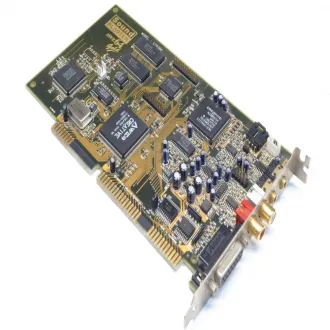The AWE32's successor, the Sound Blaster AWE64 (November 1996), was significantly smaller, being a half-length ISA card (meaning it was only half the length of the AWE32). It offered similar features to the AWE32, but also has a few notable improvements, including support for greater polyphony. However, these additional voices were achieved via software emulation using host CPU resources, called WaveGuide, rather than being processed on the card, and were thus of questionable value in some situations.
The main improvements were better compatibility with older SB models, and an improved signal-to-noise ratio. The AWE64 came in 3 versions: A Value version (with 512KB of RAM), a Standard version (with 1 MB of RAM), and a Gold version (with 4 MB of RAM and a separate SPDIF output). The 30-pin SIMM slots were replaced with a proprietary memory format which could be (expensively) purchased from Creative.
A fourth version - a PCI version of the AWE64 - was introduced shortly after. It offered the features of the original ISA AWE64, but it had the PCI interface and was built around an ASIC so it had drastically fewer components on the board and ended up being much cheaper than its predecessors. Unfortunately, at this time the issue of compatibility with older legacy DOS applications had not been ideally addressed. Creative created a motherboard port called the SB-Link which assisted the PCI bus in working with software that looked for ISA sound cards. Without this motherboard port the card was incompatible with DOS software.
AWE64 PCI was followed by the AWE64D, which was a variant of the PCI AWE64 that was developed for OEMs. It offered the same features as the retail PCI AWE64, but had an architecture that was distinct enough to prevent the standard PCI AWE64 drivers from working with it.
AWE64, in the end, was basically a revision of the AWE32. Quality of components and output was improved and cost of manufacturing was lessened. Functionality of the hardware was nearly identical. The boards were based around the AWE32's E-mu 8000 wavetable chipset, E-mu effects processor, and a Creative audio DSP and codec for digital sound playback. It was regrettable for the consumer that Creative decided to move from standard SIMM RAM expansion to their proprietary modules. Those modules were far more expensive than SIMMs and became very hard to find once the boards were out of production.
An AWE64 Mark II was also designed, prototype boards and drivers made. This added 4 speaker surround sound for games, and a hardware dolby digital decoder. The six extra phono plugs (sub/center/left rear/right rear/digital in/digital pass through) and the extra dolby decoder chips were placed on a second board which connected to the main board via a ribbon cable, and though it took up an extra card slot, it didn't actually plug into an ISA socket. The project was dropped in favour of the Live! cards due to the high expense of such a solution, and the aging ISA interface.
